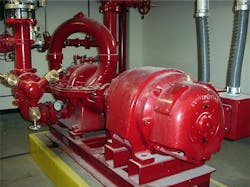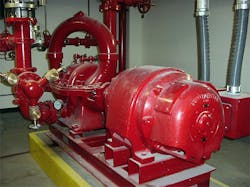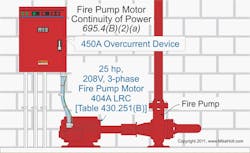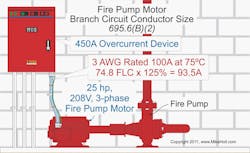Thank you for visiting one of our most popular classic articles. If you’d like to see updated information on this topic, please check out this recently published article, Fire Pump Systems. |
Note: This article is based on the 2011 NEC.
The general philosophy behind most Code requirements is to provide circuit protection that will shut down equipment before the supply conductors become overloaded, overheated, and damaged. But Art. 695 is based on a different philosophy: The fire pump motor must run, regardless of the risk to the conductors.
A fire pump supplies water to a facility’s fire protection piping. If the pump doesn’t run, not only will those conductors be damaged, but the entire facility will also be in danger of burning down. Consequently, the many requirements of Art. 695 aim to keep the pump running.
Obviously, the pump is more likely to keep running if its location minimizes exposure to fire, and doing so is an NEC requirement. This doesn’t conflict with other requirements, but many Art. 695 requirements do. For example, contrary to what other articles require, the disconnect must be lockable in the closed position [695.4(B)(3)(a)(2)].
According to the scope statement of Art. 695, it covers the installation of the fire pump supply and controls. It doesn’t cover the jockey pumps or the internal wiring of the system (Photo).
Power sources
With the 2011 NEC, the power requirements found in Art. 695 have changed extensively (see SIDEBAR: Power Source(s) for Electric Motor-Driven Fire Pumps at end of article). However, as with previous NEC editions, you must supply power from a reliable source. This source must be able to carry the locked-rotor current of the fire pump motor(s) and pressure maintenance pump motors, plus the full-load current of associated fire pump equipment [695.3(A)].
Electric motor-driven fire pumps must have a reliable source of power, which is subject to the approval of the AHJ. It needs to be one or more of the following:
- A separate electric utility service [695.3(A)(1)].
- A connection located ahead of (but not within) the service disconnecting means [695.3(A)(1)].
- An on-site power supply, such as a generator, located and protected to minimize damage by fire [695.3(A)(2)].
- A dedicated feeder derived from a service connection in accordance with 695.3(A)(1) [695.3(A)(3)].
If reliable power can’t be obtained from one of these sources, then it must be supplied by one of the following multiple sources [695.3(B)]:
- Individual sources. An approved combination of two or more of the sources from 695.3(A).
- Individual source and on-site standby generator. An approved combination of one of the sources in 695.3(A) and an on-site standby generator.
Exception to 695.3(B)(1) and (B)(2): An alternate source of power isn’t required where a back-up engine-driven or back-up steam turbine-driven fire pump is installed.
If you have:
- A multi-building, campus-style installation where the sources just discussed aren’t practicable, follow the requirements of 695.3(C).
- An on-site standby generator as an alternate source, follow the requirements of 695.3(D).
Arrange multiple sources so that a fire at one source won’t cause an interruption at the other source [695.3(E)]. Phase converters are not permitted for a fire pump service [695.3(F)].
Continuity
Circuits that supply electric motor-driven fire pumps must be supervised from inadvertent disconnection whether the conductors connect directly or through a disconnecting means and overcurrent device [695.4].
If you have a direct connection, the supply conductors must directly connect the power source either to a listed fire pump controller or to a listed combination fire pump controller and power transfer switch [695.4(A)].
If you connect through a disconnect and an overcurrent protective device (OCPD), then you can use a single disconnecting means and associated OCPD(s) between the fire pump power source and one of the following [695.4(B)(1)]:
- Listed fire pump controller.
- Listed fire pump power transfer switch.
- Listed combination fire pump controller and power transfer switch.
Select or set the OCPD to carry indefinitely the sum of the locked-rotor current of the fire pump and pressure maintenance pump motor(s), and 100% of the ampere rating of the fire pump’s accessory equipment.
If the locked-rotor current value doesn’t correspond to a standard OCPD size, then use the next standard OCPD size per 240.6 (Fig. 1). The requirement to carry the locked-rotor current indefinitely doesn’t apply to fire pump motor conductors [695.4(B)(2)(a)].
Disconnecting means
The disconnecting means for the normal power source must be [695.4(B)(3)]:
- Identified as suitable for use as service equipment.
- Lockable in the closed position.
- Not located within equipment that feeds loads other than the fire pump.
- Located sufficiently remote from other building or other fire pump source disconnecting means.
- Marked “Fire Pump Disconnecting Means.” The letters must be at least 1 in. high. People must be able to see them without opening enclosure doors or covers [695.4(B)(3)(c)].
What if an on-site generator is the alternate power source? In that case, install its disconnect per 700.10(B)(5) for emergency circuits, and ensure the disconnect can be locked in the closed position [695.4(B)(3)(a)(2)].
Transformers
If a transformer supplies an electric fire pump motor, size it at least 125% of the sum of the fire pump and pressure maintenance pump(s) motor loads, and 100% of the ampere rating of the fire pump’s accessory equipment [695.5(A)].
Size the primary OCPD to carry indefinitely the sum of the locked-rotor current of the fire pump and pressure maintenance pump motor(s), and 100% of the ampere rating of the fire pump’s accessory equipment. The requirement to carry the locked-rotor currents indefinitely does not apply to fire pump motor conductors. Secondary overcurrent protection is not permitted [695.5(B)].
Power wiring
Service conductors and conductors supplied by on-site power production facilities must be physically routed outside buildings [695.6]. Install them per Art. 230. If these conductors cannot be routed outside of buildings, then encase them in 2 in. of concrete or brick [230.6(1) or (2)].
Keep fire pump supply conductors entirely independent of all other wiring. They can supply only those loads directly associated with the fire pump system. Make sure they are protected from potential damage by fire, structural failure, or operational accident [695.6(A)(2)]. You can route fire pump conductors through a building by one of the following methods [695.6(A)(2)(d)]:
- Encase them in a minimum 2 in. of concrete.
- Run them within an enclosed construction dedicated to the fire pump circuit(s) and having a minimum of a 2-hr fire-resistive rating.
- Use a listed electrical circuit protective system protected by a fire-rated assembly listed to achieve a minimum fire rating of 2 hr and dedicated to the fire pump circuit(s).
Wiring from the fire pump controller to the fire pump motor (not installed through a building, as covered in 695.6(B)) must be in rigid metal conduit, intermediate metal conduit, electrical metallic tubing, liquidtight flexible metal conduit, liquidtight flexible nonmetallic conduit Type B, listed Type MC cable with an impervious covering, or Type MI cable [695.6(D)]. This requirement also applies to the control wiring [695.14(E)].
The voltage at the line terminals of the fire pump controller, when the motor starts (locked-rotor current), must not drop more than 15% below the controller’s rated voltage [695.7(A)].
In addition, the voltage at the motor terminals must not drop more than 5% below the voltage rating of the motor when the motor operates at 115% of the fire pump full-load current rating [695.7(B)].
Regardless of the voltage drop calculations, size the branch circuit conductors no smaller than required by [695.6(B)].
GFCI
Ground-fault protection of equipment is not allowed on fire pump equipment [695.6(G)]. The NEC doesn’t prohibit you from installing GFCI-protected receptacles in a fire pump location for portable equipment or other outlets required by the NEC to be GFCI protected.
In summary
Because the circuit protection requirements of Art. 695 differ from — and philosophically conflict with — the NEC’s other circuit protection requirements, correct application can be confusing. The central question to answer when installing fire pumps and related equipment is, “How do I make sure the pump runs no matter what?”
Remember, the fire pump must be kept in service, even if doing so damages or destroys the pump. It’s better to run the pump until its windings melt than to save the fire pump and lose the facility. The intent of Art. 695 is to save the facility.
SIDEBAR: Power Source(s) for Electric Motor-Driven Fire Pumps
Section 695.3 is the most heavily revised portion of Art. 695 in the 2011 NEC. Three key revisions worth noting include:
- Feeders originating from a separate service (or a connection upstream of the service) are now addressed and permitted as a power source.
- The provisions for multiple sources have been expanded to address on-site standby generators and combinations of services and on-site generation. The use of a generator as an alternate source has also been addressed.
- Lastly, phase converters are now specifically prohibited as a power source for fire pumps.
For more information on this topic, read "Fire Pump Systems."
About the Author

Mike Holt
Mike Holt is the owner of Mike Holt Enterprises (www.MikeHolt.com), one of the largest electrical publishers in the United States. He earned a master's degree in the Business Administration Program (MBA) from the University of Miami. He earned his reputation as a National Electrical Code (NEC) expert by working his way up through the electrical trade. Formally a construction editor for two different trade publications, Mike started his career as an apprentice electrician and eventually became a master electrician, an electrical inspector, a contractor, and an educator. Mike has taught more than 1,000 classes on 30 different electrical-related subjects — ranging from alarm installations to exam preparation and voltage drop calculations. He continues to produce seminars, videos, books, and online training for the trade as well as contribute monthly Code content to EC&M magazine.



